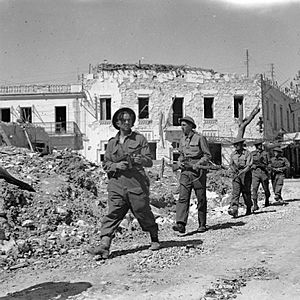Operations Vulcan and Strike facts for kids
Quick facts for kids Operations Vulcan and Strike |
|||||||
|---|---|---|---|---|---|---|---|
| Part of the Tunisian campaign of the Second World War | |||||||
 British troops advance through Bizerte in the final offensive, 8 May 1943. |
|||||||
|
|||||||
| Belligerents | |||||||
| Commanders and leaders | |||||||
| Casualties and losses | |||||||
| 240,000 captured | |||||||
Operation Vulcan (April 22 – May 6, 1943) and Operation Strike (May 6–12, 1943) were the final ground attacks. These were carried out by the Allied forces against Italian and German forces. The battles took place in Tunis, Cape Bon, and Bizerte, which were the last places the Axis still controlled in North Africa. These operations were part of the Tunisian campaign during the Second World War.
Contents
Why the Allies Attacked in Tunisia
Allied forces landed in French North Africa in July 1942. By November 1942, the British Eighth Army had pushed Axis forces. They moved them away from Egypt and across Libya. This left only Tunisia under Axis control.
A top German general, Erwin Rommel, believed the Axis position in Tunisia was impossible to hold. He suggested that all German troops should go back to Italy. He thought they would be more useful there. But Adolf Hitler, the leader of Germany, rejected his advice.
The Allied air force also launched Operation Flax. This operation cut off Axis supplies to North Africa. It also gave the Allies control of the skies. With the naval Operation Retribution, the Allies controlled both the air and sea. This stopped any large escape of Axis troops to Italy.
The Operations Begin
Operation Vulcan: The First Push
The fighting during Operation Vulcan was very difficult. German units had strong defenses, dug deep into the ground. In the advance towards Tunis, British soldiers faced tough German paratroopers. These paratroopers were from an elite unit called the Division 'Hermann Göring'.
At a place called Cactus Farm, British infantry faced heavy fire. The German paratroopers were well hidden. Churchill tanks advanced without infantry support. The German defenders attacked these tanks with Molotov cocktails and sticky anti-tank mines. Twelve tanks were destroyed. In some cases, the German soldiers even rescued the crews from the burning tanks.
Operation Strike: The Final Attack
By April 30, it was clear that a new plan was needed to win. This revised final attack on Tunis was named Operation Strike. It began six days later, on May 6.
General Brian Horrocks was put in charge of the British IX Corps. His job was to break through the enemy lines. For this battle, IX Corps received extra experienced units. These included the 7th Armoured Division and the 4th Indian Division.
The plan was for the 4th British Division and 4th Indian Division to attack the enemy. They would attack on a narrow front. Then, the 6th and 7th Armoured Divisions would quickly move through the gap. Their goal was to capture high ground west of the city. Other Allied units also had important roles.
The operation started at 3 AM with troops moving forward. Artillery guns fired many shells at enemy positions. Four hundred guns were used on a front of about 3,000 yards (2.7 km). In just two hours, over 16,000 shells were fired.
At dawn, aircraft from the Northwest African Tactical Air Force provided support. Bombers, fighter-bombers, and fighters flew nearly 2,000 missions in 24 hours.
On the morning of May 7, the 6th and 7th Armoured Divisions faced little resistance. By the afternoon, the 26th Armoured Brigade could see Tunis. Patrols from the 1st Derbyshire Yeomanry and 11th Hussars reached the center of Tunis around 4 PM.
On that same day, the British First Army took Tunis. American troops also reached Bizerte. The U.S. II Corps surrounded the last defenders at Enfidaville. This ended the Axis effort in North Africa. The German commander, General Hans-Jürgen von Arnim, finally surrendered on May 12.
The End of the Campaign
On May 13, all remaining Axis forces in Tunisia surrendered without conditions. Their commander, Marshal Giovanni Messe, had tried to negotiate an "honorable surrender" the day before. However, the Allies refused. They demanded a complete surrender and threatened to restart their attacks. At 12:20 PM, Messe gave the orders to surrender. By the end of the operation, nearly 240,000 German and Italian troops had been captured.
See also

